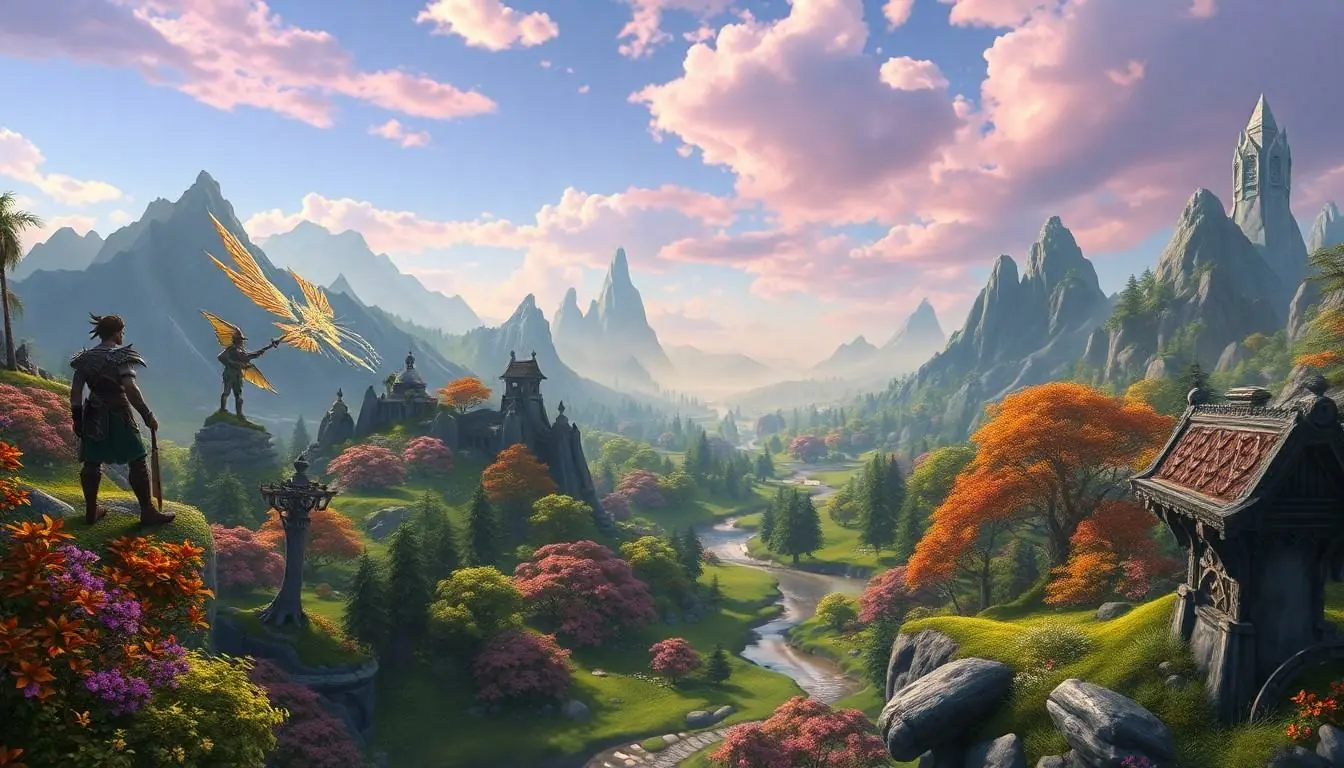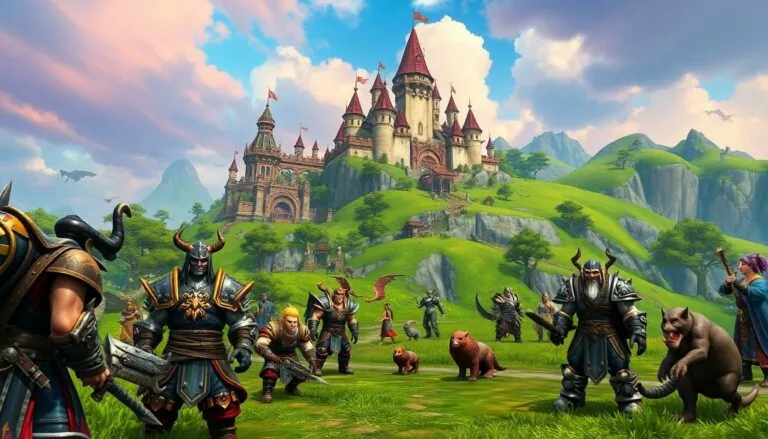Table of Contents
ToggleIn the vast realm of Azeroth, where epic quests and legendary battles unfold, the graphics of World of Warcraft have become a character of their own. From lush forests to sprawling cities, the visuals transport players into a world bursting with color and creativity. But let’s be honest—sometimes those graphics feel like they’ve been on a diet since 2004.
Yet, despite their age, there’s a certain charm to the whimsical art style that keeps players coming back for more. It’s like that old pair of jeans—faded, a little worn, but oh-so-comfortable. As Blizzard continues to sprinkle in updates and enhancements, the graphics evolve while maintaining the nostalgia that keeps the community thriving. Dive in to explore how these visuals not only shape gameplay but also create unforgettable memories in this pixelated paradise.
Overview of World of Warcraft Graphics
World of Warcraft graphics showcase a distinctive aesthetic that blends fantasy with vibrant colors. Since 2004, the visuals have charmed players, despite some aspects appearing outdated. The art style remains whimsical, providing a comfortable familiarity akin to a favorite pair of jeans. Blizzard consistently implements updates and enhancements, allowing for the evolution of the game’s graphics while maintaining nostalgic elements.
Player immersion benefits significantly from the game’s unique graphics. Characters and environments exhibit a level of detail that enriches gameplay experiences. The character models display exaggerated features that enhance emotional connections, making every interaction memorable. Environments throughout Azeroth feature diverse biomes, each represented with distinct textures and lighting effects to immerse players fully.
Seasonal updates introduce themed aesthetics, such as the festive winter season that enlivens landscapes with snow and decorations. Character customization options further allow for artistic expression, giving each player a special touch in the game world. Items and mounts also contribute varied visual elements that reflect player achievements and personality.
Community engagement thrives through the visuals, as players share screenshots and artwork inspired by their adventures. This visual storytelling fosters connections among players and reinforces the sense of belonging within the World of Warcraft universe. Overall, graphics play a crucial role in gameplay and the shared experiences that define this iconic MMORPG.
Evolution of Graphics Over the Years
Graphics in World of Warcraft have undergone significant changes since the game’s launch. Each expansion brought not only new content but also graphical improvements that enhanced player experiences.
Classic Era Graphics
Classic World of Warcraft featured graphics that, while iconic, appeared dated by today’s standards. Character models were relatively simple, with limited textures and animations. Environments boasted unique designs, but they lacked the detail seen in later expansions. Despite their simplicity, these graphics cultivated a strong sense of nostalgia among players. The whimsical art style and vibrant colors created a memorable world that drew players into Azeroth.
The Burning Crusade and Wrath of the Lich King
With The Burning Crusade, graphical enhancements began to emerge, introducing improved models and textures. More detailed character designs elevated player immersion. Environments showcased diverse landscapes, from the shattered lands of Outland to the icy depths of Northrend. Wrath of the Lich King continued this trend, adding atmospheric effects that enhanced the overall aesthetic. This era marked a transition where graphical fidelity became more pronounced while retaining the game’s distinctive art style.
Modern Graphics Enhancements
Modern updates have significantly upgraded World of Warcraft graphics, making significant strides in realism and detail. Enhanced character models showcase finer features and smoother animations, enriching player interactions. New technologies improve lighting effects and environmental textures, bringing the world to life in unprecedented ways. Seasonal updates regularly introduce fresh visual themes, keeping the game visually engaging. Customization options offer players the chance to showcase their unique styles in a vibrant and visually rich environment.
Art Style and Aesthetics
World of Warcraft showcases a distinct art style that captivates players. This unique aesthetic enhances immersion and connects players to the game.
Unique Artistic Choices
Blizzard’s artistic decisions stand out, blending realism with fantasy elements. Character designs feature exaggerated proportions, making figures iconic. Environments showcase whimsical structures alongside fantastical creatures. Each expansion introduces fresh artistic choices, enriching the game’s visual identity. Details like armor textures and animations reflect careful attention, creating a cohesive world. Iconic locales, such as Dalaran and Orgrimmar, demonstrate creativity through architecture and vibrant details. These choices not only fuel nostalgia but also allow for ongoing player engagement.
Color Palette and Environmental Design
World of Warcraft employs a vibrant color palette that elevates its landscapes. Bright hues dominate the landscapes, aligning with the game’s playful theme. Each zone features unique colors that evoke specific emotions, from the lush greens of Elwynn Forest to the fiery reds of Hellfire Peninsula. Environmental design integrates these colors with varied terrain and atmospheric effects, resulting in immersive settings. Seasonal updates introduce themed aesthetics, keeping the visuals fresh and exciting. Areas like Stormwind blend historical architecture with colorful blossoms, enhancing the enchanting experience players enjoy. Ultimately, color and design work together to create a rich tapestry across Azeroth.
Technical Aspects of World of Warcraft Graphics
World of Warcraft’s graphics rely on a robust engine that continuously evolves to enhance gameplay experiences. Performance optimizations focus on improving frame rates and reducing loading times. Players benefit from features like dynamic lighting and shadowing effects that create immersive environments. Additionally, continuous updates ensure that older hardware remains compatible, extending accessibility across various systems.
Engine and Performance Optimizations
The game engine powers mesmerizing visuals while maintaining smooth performance. Enhancements like the updated rendering pipeline contribute to workspace efficiency in graphics processing. Advanced optimizations allow for better texture loading without overwhelming system resources. As a result, players experience sharper graphics in expansive settings. Developers prioritize user experience through continual performance tweaks, ensuring smooth gameplay during intense encounters.
System Requirements and Compatibility
System requirements for World of Warcraft maintain their evolution alongside graphical updates. The minimum requirements include an Intel Core i5 or AMD equivalent and 4 GB RAM for smooth gameplay. Recommended specifications feature faster processors and higher RAM, such as an Intel Core i7 with 8 GB RAM, allowing for optimal graphic capabilities. Compatibility stretches across Windows and macOS platforms, ensuring a broad audience can enjoy the game. Regular patches help improve compatibility with newer operating systems while enhancing graphical fidelity.
Community Feedback and Reception
Players consistently express appreciation for the graphics of World of Warcraft, noting the charming art style. Many feel a sense of nostalgia, recalling their early experiences while exploring Azeroth. Reviews often highlight the whimsical designs of characters and environments that resonate with long-time fans.
Expansions have received feedback that ranges from excitement to constructive criticism. While some players celebrate improvements in graphical fidelity, others mention a desire for even more enhancements. Specific areas, such as character animations and environmental textures, garner particular attention for their visual quality.
Community forums frequently buzz with discussions about seasonal updates. Enthusiasts enjoy how these updates introduce fresh aesthetic elements, keeping visuals engaging. Players share their own screenshots, showcasing personal adventures, and often exchange tips to optimize visual settings.
Artistic choices spark varied reactions within the community. The blend of realism and fantasy elements elicits admiration, yet some players favor a more traditional aesthetic. Reactions can depend on individual preferences, shaping discussions about the game’s visual identity.
Performance optimizations also play a vital role in player satisfaction. Many appreciate smoother frame rates and reduced loading times, which enhance the overall gameplay experience. The graphical engine continues to adapt, resulting in ongoing community dialogue around future potential enhancements.
Ultimately, community feedback reflects the deep connection players share with World of Warcraft’s graphics. This connection remains crucial in shaping ongoing updates and the game’s evolving visual landscape.
Conclusion
World of Warcraft’s graphics continue to captivate players with their unique charm and whimsical art style. The blend of nostalgia and modern enhancements creates a visually engaging experience that fosters community connections. As Blizzard evolves the graphics through expansions and seasonal updates, players enjoy a rich tapestry of environments and character designs that invite personal expression.
The game’s robust engine ensures smooth performance while delivering stunning visuals, allowing players to immerse themselves in the vibrant world of Azeroth. Ultimately, the graphics not only enhance gameplay but also cultivate lasting memories and a strong sense of belonging within the community.





